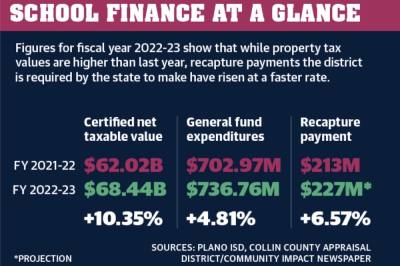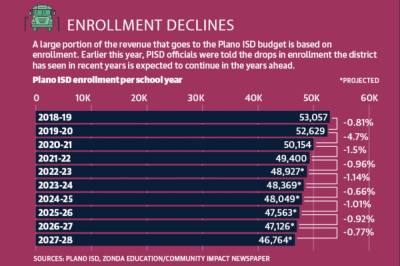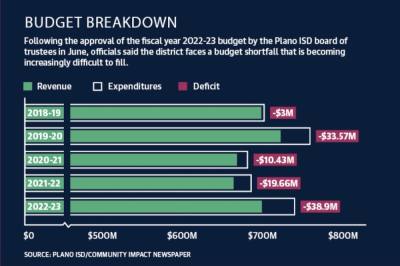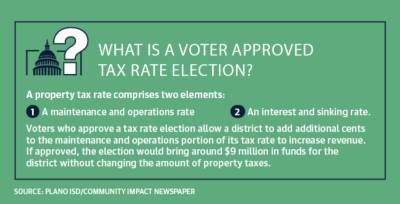Despite a projected increase in revenue, the district budget is affected by a decreasing student population—which affects its average daily attendance funding—a proposed tax rate that is about 3% lower than the year before and a need to offer salaries that are competitive with neighboring districts, according to the budget document.
PISD is projected to earn about $698 million in revenue in FY 2022-23. Expenditures are projected to reach about $736 million, leaving the district with a projected budget deficit of more than $38 million.
The majority of the budget’s planned expenditure increases comes in the form of a rising recapture payment. Property values in the district rose by about 7%, which will generate an additional $13.4 million in property tax revenue; however, the district’s recapture amount is expected to increase by $13.9 million, according to the budget.
The budget shows that PISD is projected to pay nearly $227 million in recapture funds during FY 2022-23. Recapture redistributes property tax dollars from property wealthy districts to those the state deems property poor.
PISD can actively address the budget deficit with minimal effect on staff and students because of a healthy fund balance, Deputy Superintendent Johnny Hill said. The district has options, including a proposed voter-approval tax rate election, or VATRE, that was presented at a board of trustees meeting Aug. 2.
“There’s not just one way to get out of a budget deficit,” Hill said.
Competitive pay
Included in the budget are general pay increases for district faculty and staff. Teachers, librarians and nurses are receiving a 4% pay increase, and all other employees are receiving a 3% pay increase. About 86% of the expenditure budget is spent on payroll for employees.
PISD is expected to spend about $13 million more on instruction this year, despite decreasing its staff size by about 7% in the past five years. Part of this comes down to pay increases, which allow PISD to maintain a competitive balance with surrounding districts, according to officials.
“At a time when educators are facing more challenges than ever, Plano ISD is working hard to recruit and retain staff,” Superintendent Theresa Williams said in an email.
The Texas Association of School Boards offers consulting services to school districts, including PISD. The TASB’s Human Resources Services department can provide customized pay studies, employee surveys and reviews of operations and staffing, according to its website.
Districts across the state are dedicating large pay increases to faculty and staff ahead of the new school year, said Amy Campbell, director of the TASB’s HR Services.
“Those pay rates are increasing by double-digit percentages in some districts to get to more livable wages for its staff,” she said. “So they’re having to make some tough decisions about where to spend the limited funds they have.” School districts typically reserve between 80%-85% of their budgets for staffing costs, Campbell said. Districts cannot make big changes in paying employees without affecting the rest of the budget.
“It’s like turning the Titanic,” she said.
Each year, a district decides how much money it can spend while remaining sustainable. Even with a projected deficit, a district can consider itself sustainable while looking ahead by a year or two, Campbell said.
PISD started its fiscal year with about $255 million in its fund balance, the budget shows. That figure is expected to fall to about $215 million by the end of the fiscal year, per PISD.
“A district would say, ‘We’re willing to adopt a deficit budget to give our teachers a pay increase this year,’” she said. ‘“Because if we don’t, we’re going to lose 20% of our teaching staff and not be able to fill classrooms with qualified, certified teachers.’”
Average daily attendance
Texas allots funding per student based on an average daily attendance rate, according to the Texas Education Agency. However, those allotments are not indexed for inflation, Hill said. Over the past year, the Consumer Price Index increased by 9.1%, the largest increase in 40 years, according to the U.S. Bureau of Labor Statistics. As inflation rises, the district loses buying power while any excess funds are recaptured, Hill said.
Additionally, PISD’s student enrollment has dropped about 7% in the last five years. That figure is projected to keep falling until FY 2031-32, according to the budget.
Average daily attendance has also been falling since FY 2014-15, according to the budget. The figure measures the total number of students who were in attendance each day of the school year, said Allen Garner, a Region 10 field service agent and former superintendent, in an email. As the average daily attendance goes down, so does the amount of state funding a district can receive.
“The only way for our budget to grow is if we grow [enrollment],” Hill said.
Rocky Gardner, director of school district consulting at Zonda Education, a company that calculates enrollment projections, presented a report on PISD’s demographic projections to the board in February. Despite PISD’s population growing by about 12% between 2010-2020, the population of children under age 18 fell by about 6%.
Since FY 2018-19, the district lost more students than it gained each year, according to Gardner’s presentation. Enrollment numbers did not bounce back as much as Zonda Education officials projected in the year following COVID-19, he said.
Despite the fluctuations, Gardner pointed out that the district could see a lot of growth in the coming years. There are about 540 housing lots in the district with an additional 3,261 lots in planning stages, Gardner said.
About 750 multifamily units are also under construction, which should impact the district in one to two years, Gardner said. However, those units could amount to less than 70 students, Gardner said.
VATRE
PISD’s board was slated to consider calling a voter-approval tax rate election at its Aug. 16 meeting. If that is called, it could help alleviate deficit concerns. The proposed tax rate, about $1.26 per $100 valuation, will realign the district’s tax structure while presenting a rate lower than last fiscal year by about $0.061.
PISD officials said the new tax rate will maximize the district’s maintenance and operations budget while reducing some of the budget deficit by about $9 million. Hill presented information on the proposed tax rate during an Aug. 2 board meeting, stressing the importance of tackling the district’s budget deficit.
The proposed tax rate will also help offset the loss of about $17 million in federal funding grants related to COVID-19 response measures, which are expected to expire in FY 2023-24 and FY 2024-25.
Despite the proposed tax rate being lower than the previous fiscal year, it is still a high enough increase that the district is required to call for an election. If the election fails, the tax rate will default to the voter-approved tax rate at about $1.23 per $100 valuation. If the election is called, the rate will be on the ballot for voters to consider on Nov. 8. As of press time Aug. 15, the election had not been finalized.
William C. Wadsack contributed to this report.









